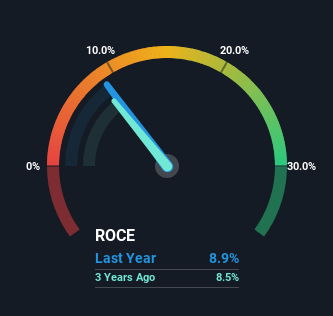Returns On Capital Signal Tricky Times Ahead For Sumitomo Heavy Industries (TSE:6302)
What are the early trends we should look for to identify a stock that could multiply in value over the long term? One common approach is to try and find a company with returns on capital employed (ROCE) that are increasing, in conjunction with a growing amount of capital employed. Basically this means that a company has profitable initiatives that it can continue to reinvest in, which is a trait of a compounding machine. Although, when we looked at Sumitomo Heavy Industries (TSE:6302), it didn't seem to tick all of these boxes.
Understanding Return On Capital Employed (ROCE)
For those that aren't sure what ROCE is, it measures the amount of pre-tax profits a company can generate from the capital employed in its business. To calculate this metric for Sumitomo Heavy Industries, this is the formula:
Return on Capital Employed = Earnings Before Interest and Tax (EBIT) ÷ (Total Assets - Current Liabilities)
0.089 = JP¥77b ÷ (JP¥1.3t - JP¥394b) (Based on the trailing twelve months to June 2024).
So, Sumitomo Heavy Industries has an ROCE of 8.9%. In absolute terms, that's a low return but it's around the Machinery industry average of 7.9%.
View our latest analysis for Sumitomo Heavy Industries

Above you can see how the current ROCE for Sumitomo Heavy Industries compares to its prior returns on capital, but there's only so much you can tell from the past. If you'd like to see what analysts are forecasting going forward, you should check out our free analyst report for Sumitomo Heavy Industries .
The Trend Of ROCE
In terms of Sumitomo Heavy Industries' historical ROCE movements, the trend isn't fantastic. Over the last five years, returns on capital have decreased to 8.9% from 12% five years ago. However it looks like Sumitomo Heavy Industries might be reinvesting for long term growth because while capital employed has increased, the company's sales haven't changed much in the last 12 months. It may take some time before the company starts to see any change in earnings from these investments.
Our Take On Sumitomo Heavy Industries' ROCE
Bringing it all together, while we're somewhat encouraged by Sumitomo Heavy Industries' reinvestment in its own business, we're aware that returns are shrinking. Unsurprisingly, the stock has only gained 28% over the last five years, which potentially indicates that investors are accounting for this going forward. As a result, if you're hunting for a multi-bagger, we think you'd have more luck elsewhere.
On a final note, we've found 2 warning signs for Sumitomo Heavy Industries that we think you should be aware of.
If you want to search for solid companies with great earnings, check out this free list of companies with good balance sheets and impressive returns on equity.
Have feedback on this article? Concerned about the content? Get in touch with us directly. Alternatively, email editorial-team (at) simplywallst.com.
This article by Simply Wall St is general in nature. We provide commentary based on historical data and analyst forecasts only using an unbiased methodology and our articles are not intended to be financial advice. It does not constitute a recommendation to buy or sell any stock, and does not take account of your objectives, or your financial situation. We aim to bring you long-term focused analysis driven by fundamental data. Note that our analysis may not factor in the latest price-sensitive company announcements or qualitative material. Simply Wall St has no position in any stocks mentioned.
 Index Options
Index Options CME Group
CME Group Nasdaq
Nasdaq Cboe
Cboe TradingView
TradingView Wall Street Journal
Wall Street Journal